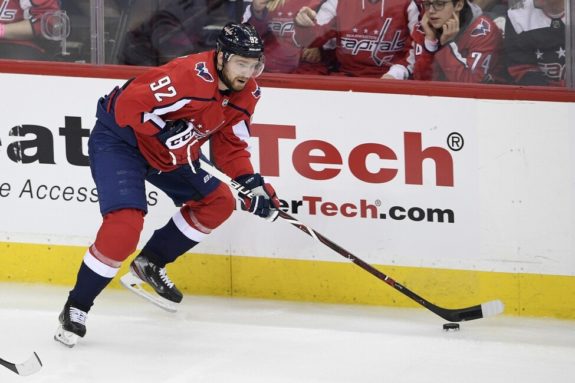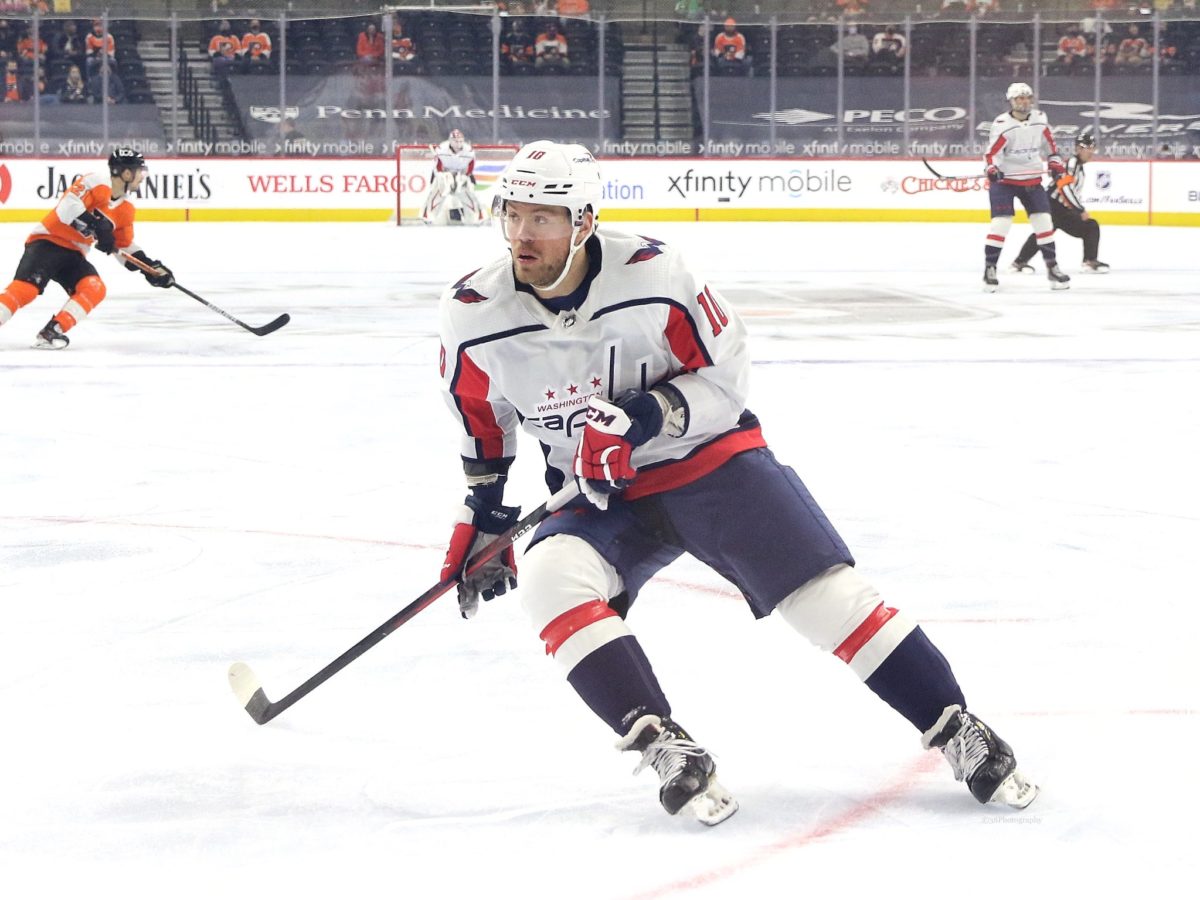In a little over a month, fans will be gifted something they haven’t been privileged to since 2019: a full NHL season (knock on wood with wooden sticks). The Washington Capitals have some of the most recognizable names in the league on offense, and with new deals being had and the bitter taste of frustrating early exits from the last three postseasons, expect all the stars to be motivated. Of course, there are storylines still to monitor throughout the year.
Capitals’ 2021-22 Projected Forward Groups
The Capitals have one of the most dangerous offenses in the league, and barring any unfortunate injury—or suspension—they will once again flourish in their opponents’ defensive zone. There are some key players to follow, however. Head coach Peter Laviolette has a good idea of how the season will start, but if certain skaters don’t step up like they can, or are supposed to do, then tinkering with the lines may happen early.
Line 1: Ovechkin-Kuznetsov-Wilson
The grouping of Alexander Ovechkin, Evgeny Kuznetsov and Tom Wilson had an off-year in 2020-21. Each was forced to miss games due to injuries and suspensions, and of the 56 regular-season matches played, those three skated in 45, 41 and 47 games, respectively. Together, they were only absent for eight games total in 2019-20.

The trio missed, on average, 21% of Washington’s matches, and therefore, only accounted for 21% of the team’s points. Those numbers are not good enough. In 2017-18, the three produced 29% of the team’s points and 35% of their goals with a plus-16 rating. In 2018-19, the NHL’s last full season, the top line contributed 27% of points and 34% of goals—and that’s even considering Wilson missed 19 games that season.
To return to that level of productivity, two things must happen. Kuznetsov needs to find himself and Wilson must continue to develop. The 27-year-old is more than an intimidating presence. His points-per-game has increased from .12 to .70 in eight seasons. If these three are functioning on all cylinders, they are one of the top lines in the league.
Line 2: Mantha-Backstrom-Oshie
Nicklas Backstrom and T.J. Oshie stepped up for the Capitals last season, especially during key stretches when the team was depleted. If Jakub Vrana and Anthony Mantha’s stats are combined, this grouping accounted for 26% of the team’s points and 28% of the team’s goals.
Backstrom can play center with anyone and increases any player’s productivity. The key to this line contributing at the rate they’re capable of is Mantha’s performance and availability. The big winger has never played a full season, not even when the seasons were shortened. His plus-minus rating has been in the green just once, and his points-per-game average was .57 during his short stint last season with the Capitals, which was down from his average of .64 in six seasons with Detroit. With a Hall-of-Fame caliber center and a perineal 20-plus goal scorer skating on the other side, Mantha has a great opportunity to have his best season.
Line 3: Sprong-Eller-Sheary
Washington’s third line is more defensive-minded. Lars Eller is most valuable for his work in the faceoff circle, supporting the blue line, and serving on the penalty kill. Conor Sheary had a very solid 2020-21 campaign. The winger was on an 82-game pace to post 34 points, which would have tied his second-highest season total. He’s a grinder, who plays and understands his role well.

Daniel Sprong is the possible X-factor to follow. These three players contributed 13% of Washington’s total points and 19% of their goals. This, however, was because Sprong was given an opportunity while Ovechkin was out. It is uncertain if his productivity will increase while solidifying a spot on the third line or if he will give an offensive pop to a forward group not usually depended on to fetch points.
Line 4: Hagelin-Dowd-Hathaway
If there’s one thing the Capitals don’t have to worry about this season, it’s their fourth-line forwards. Carl Hagelin, Nic Dowd and Garnet Hathaway skated in all 56 games last year. They produced 49 points and a combined plus-minus rating of plus-18. The reason that’s so impressive is that they are a defensive-oriented line, and Dowd and Hagelin are the main forward pair on the penalty kill. In the last two years, the Capitals have finished sixth and fifth in the league with 82.6% and 84% success rates while shorthanded.
Not only are their contributions vast, but they’re also timely. Dowd registered four points in the Capitals’ final five games to push them to a high playoff seed and tipped in the overtime winner in Game 1 against the Boston Bruins. Hathaway was on an 82-game pace to total 26 points, which would have been the best season of his career by far.
The fourth line was the most reliable for Washington all of last year. They don’t have to change anything, but they must be wary of future change. Hagelin’s productivity has decreased even though his speed and defensive abilities still remain. The 33-year-old veteran winger will most likely be out of D.C. after the 2022-23 season because his cap hit demands $2.75 million per year. Hathaway will have to prove he’s worth re-signing that same offseason—his current contract is $1.5 million annually. Dowd is an unrestricted free agent after this year and currently plays at a discount, only $750,000 against the cap. Look for the 31-year-old to get an extension during the season or re-sign next summer.
What To Watch For
The three main storylines to watch for are Kuznetsov’s rebound, Mantha’s health, and Sprong’s development. If the Russian center fails to return to his level of play, he may shift between the first and second lines to see which wingers he meshes best with. Luckily for Washington, Backstrom is Backstrom, so possible center swaps could happen periodically this season. Also, if Kuznetsov fails to overcome his decline and off-ice issues, he’s likely to be moved far beyond just a new line and to a new city.
Mantha will come into his own with the Capitals, and he showed signs of his ability early. If he can stay on the ice, then he and Oshie will be a formidable duo on the second line. Also, his presence on the second power-play unit will give penalty killers fits and little relief after the first line takes a break.
Sprong is perhaps the most intriguing storyline regarding Washington forwards. Proving that his play when Ovechkin was out of the lineup wasn’t just opportunistic will be key. He has been given a chance to showcase his abilities, and it could earn him a nice new deal next summer. If not, expect some young guns from Hershey to be given more NHL ice time, and potentially yet another trade at the spring deadline for an extra offensive edge.
Certain players have something to prove, but redemption will be a shared philosophy in the Capitals’ locker room. If they figure it all out early, the league should be on high alert.